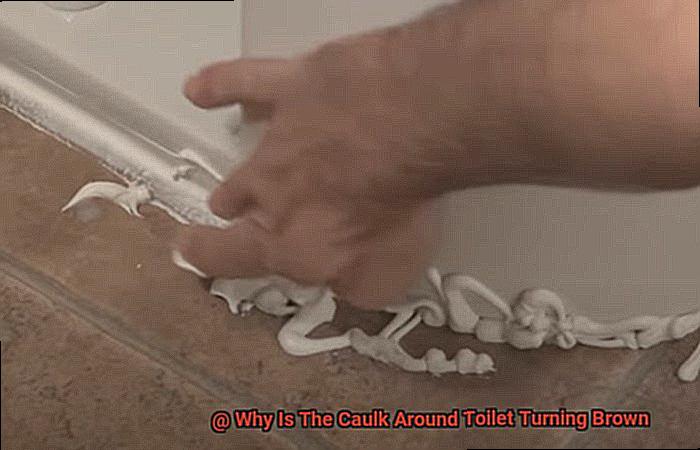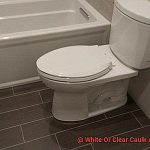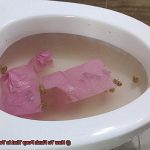Have you ever noticed the caulk around your toilet turning an unsightly shade of brown?
Don’t worry, you’re not alone. This is a common problem that affects many homeowners and renters, regardless of the age or condition of their bathroom.
But what causes this issue in the first place? In this blog post, we’ll delve into the reasons behind the brown discoloration of your toilet caulk, and explore the various culprits that can lead to it.
From mold and mildew to humidity and water damage, we’ll cover all the potential causes. Not only will you learn how to spot the warning signs of a caulk disease, but you’ll also discover the risks it poses to your health and wellbeing.
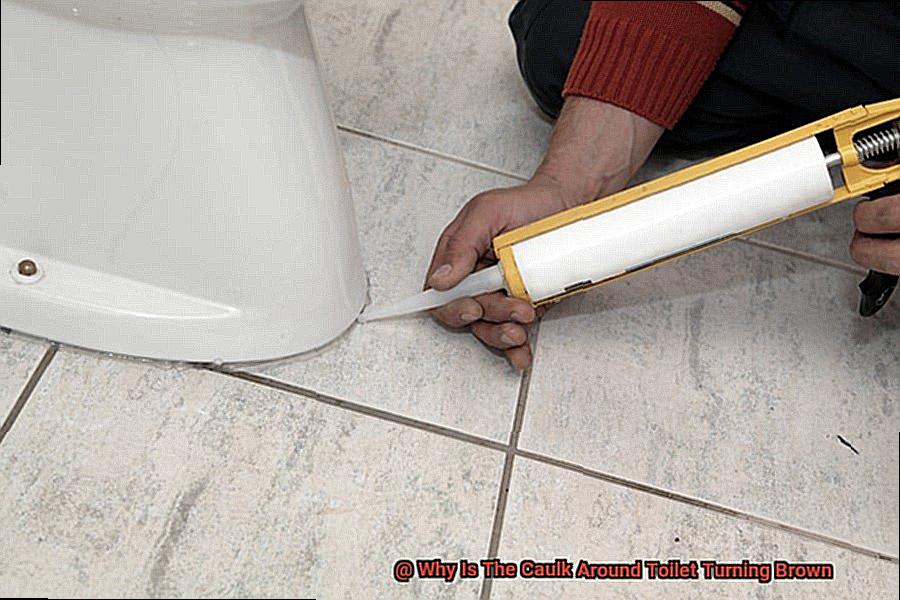
So, if you’re ready to get to the bottom of why your toilet caulk is turning brown, let’s dive into the science behind this pesky issue.
Contents
What is Caulk and Why Is It Used Around Toilets?
Caulk: The Superhero That Saves Your Bathroom From Water Damage
If you’re wondering why caulk is used around toilets, let me tell you – it’s like the icing on the cake. Caulk acts as a sealant that fills gaps and cracks in various surfaces, including around toilets.
It’s typically made of silicone or latex and can be found in clear or colored varieties. But why is it important to use caulk around your toilet?
Caulk is like a superhero that saves your bathroom from water damage. It forms a watertight seal between the toilet and the floor, ensuring that no moisture seeps into the toilet and causes harm.
Without caulk, your bathroom could be prone to significant water damage, which may lead to mold growth and unpleasant odors. Caulking around a toilet is an important step in ensuring that your bathroom remains clean, dry, and free from water damage.
However, brown caulk can be quite obnoxious. But why does caulk turn brown in toilets?
There are several reasons for this occurrence. Firstly, moisture buildup around the toilet’s base or under the caulk can result in a damp environment that is perfect for mold and mildew growth.
Mold and mildew can cause discoloration and staining of the caulk, resulting in a brownish shade. Secondly, poor quality or old caulk can also turn brown over time.
If the caulk used during installation is of poor quality or has exceeded its lifespan, it will start to break down and deteriorate over time, causing discoloration and staining of the caulk. Lastly, cracks or holes in the caulk will allow water to seep through and accumulate under the caulk, leading to mold and mildew growth that may cause discoloration and staining of the caulk.
So what can you do about brown caulk in your toilet? The best option is to remove the old caulk and replace it with a new, high-quality caulk.
This will guarantee that your toilet is spotless, dry, and free of water damage. In summary, caulking around your toilet is vital in retaining cleanliness and sanitation in your bathroom.
Causes of Caulk Turning Brown Around Toilet
Discoloration of caulk can occur due to various reasons.
Let’s dive into the causes and solutions for brown caulk around your toilet. The primary cause of brown caulk is age-related wear and tear.
Over time, the caulk can become discolored and stained due to exposure to water and other elements in the bathroom. Replacing old caulk with high-quality new caulk is the solution to keep your toilet free of water damage.
Mold or mildew growth is another possible cause of brown caulk. Moisture seeping behind the caulk or other areas in the bathroom can lead to mold and mildew growth, which causes discoloration and poses health risks.
Properly ventilating your bathroom and promptly repairing any leaks can prevent mold and mildew growth. Rust is also a potential suspect of brown caulk.
Metal parts in the toilet or nearby plumbing that are rusting can cause the caulk to discolor. Hard water with mineral deposits can also build up on the caulk and turn it brown.
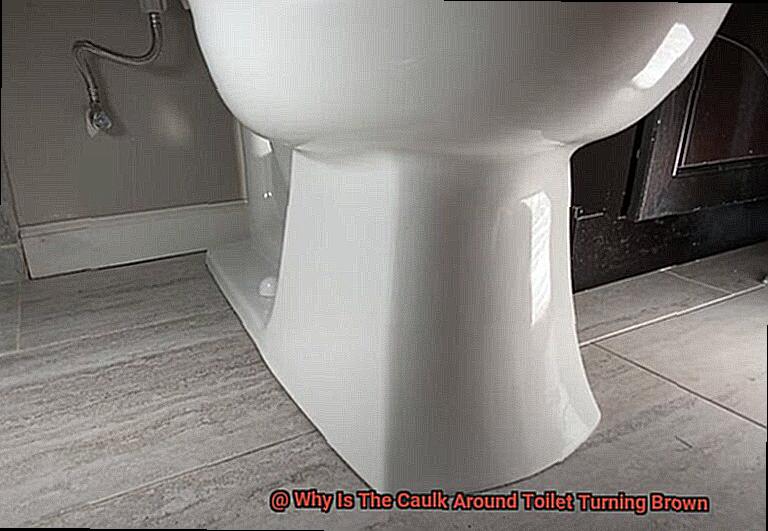
To prevent this, consider using a water softener. Certain cleaning products can contribute to brown staining on the caulk.
Abrasive scrubbers or harsh chemicals can wear away at the caulk and cause discoloration. Use gentle cleaning agents to prevent abrasive damage to the caulk.
Regular maintenance, good ventilation, and gentle cleaning agents can keep mold, mildew, and discoloration at bay.
Accumulation of Moisture
One of the most common reasons for this unsightly occurrence is the accumulation of moisture.
Picture your bathroom as a rainforest – after a heavy downpour, humidity levels skyrocket, and water pools around the base of your toilet. Over time, this moisture seeps into the caulk and causes it to turn brown.
But that’s not all; mold and mildew can also thrive in this damp environment, posing a health risk to those with respiratory issues. To prevent further damage to your caulk and your health, it’s crucial to take action immediately.
Regularly check your toilet’s plumbing for leaks or cracks to prevent moisture buildup. Use a bathroom fan or open a window while showering to reduce humidity levels in the bathroom.
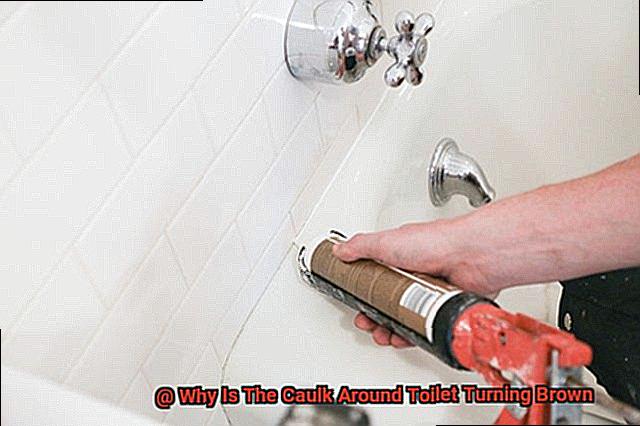
If you’re already dealing with brown caulk due to moisture accumulation, it’s time to replace it entirely. By removing the old caulk, you’ll eliminate any existing mold or mildew growth and prevent further moisture from penetrating the new caulk.
To prevent future discoloration, choose a waterproof caulk specifically designed for bathroom use. Don’t let moisture buildup ruin your bathroom’s appearance or endanger your health.
Poor Quality or Old Caulk
Caulk is the vital rainforest canopy of your bathroom, protecting everything against external elements by sealing gaps and joints.
However, just like a weakened canopy can cause numerous issues, so can poor quality or old caulk. Over time, exposure to moisture, heat, sunlight, and other environmental factors can cause caulk to break down, lose its elasticity and become discolored.
This is not only unsightly but also creates a perfect setting for mold and mildew growth, which can pose a health hazard. To avoid such problems, it’s crucial to use high-quality caulk that is specifically designed for use in wet areas.
Before applying new caulk, ensure that the area is cleaned thoroughly and allowed to dry completely. It’s also vital to remove any old caulk or residue before applying the new one.
In addition to proper application, regular maintenance of your toilet caulk is essential to prevent discoloration and other issues. Check the caulk periodically for signs of wear and tear and replace it as needed.
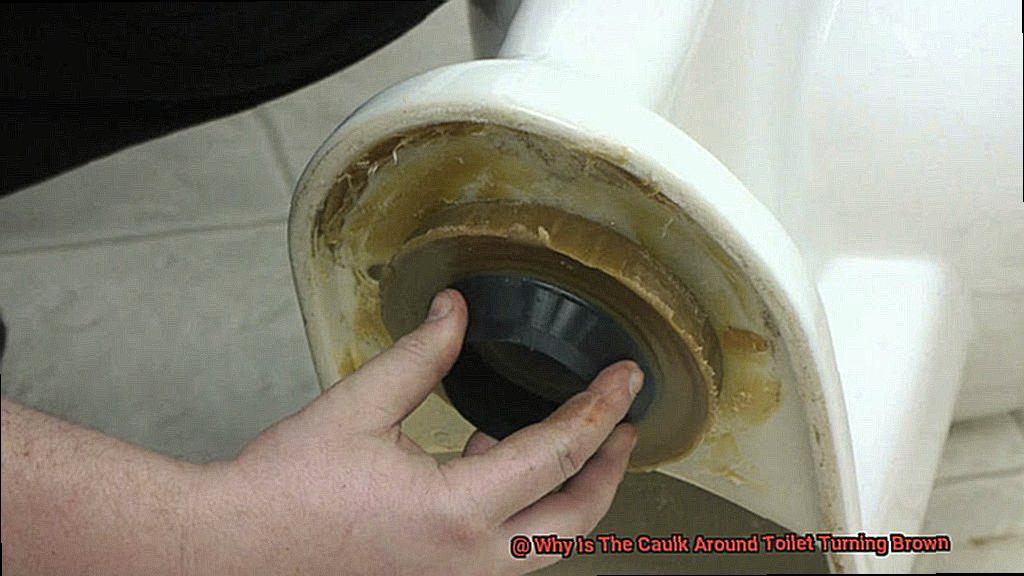
By taking these measures, your toilet caulk will last for years without becoming discolored or damaged. In conclusion, poor quality or old caulk is a common culprit behind toilet caulk discoloration.
To avoid this problem, invest in high-quality caulk designed specifically for wet areas, take time to clean and replace any damaged or worn-out caulk regularly.
Cracks or Gaps in the Caulk
One of the most common reasons for this phenomenon is cracks or gaps in the caulk around the toilet’s base.
These crevices can permit moisture to seep in and encourage mold and mildew growth, leading to unsightly brown stains. To avoid this issue, it’s crucial to regularly inspect and maintain the caulk around your toilet.
Check the caulking every six months for signs of wear or damage. If you find any cracks or gaps, it’s crucial to patch them immediately with new caulk.
When selecting caulk for your toilet, go for a high-quality silicone product that is designed specifically for use in bathrooms. These types of caulks are resistant to water and mold growth, making them suitable for wet areas such as toilets.
Before applying new caulk, make sure the area is clean and dry. Start by removing any old caulk and thoroughly sanitizing the area with a toilet cleaner or rubbing alcohol.
Apply a thin, continuous bead of caulk along the joint after the area is clean and dry, being careful not to overapply. Finally, smooth the caulk with a caulk smoothing rod or your finger.
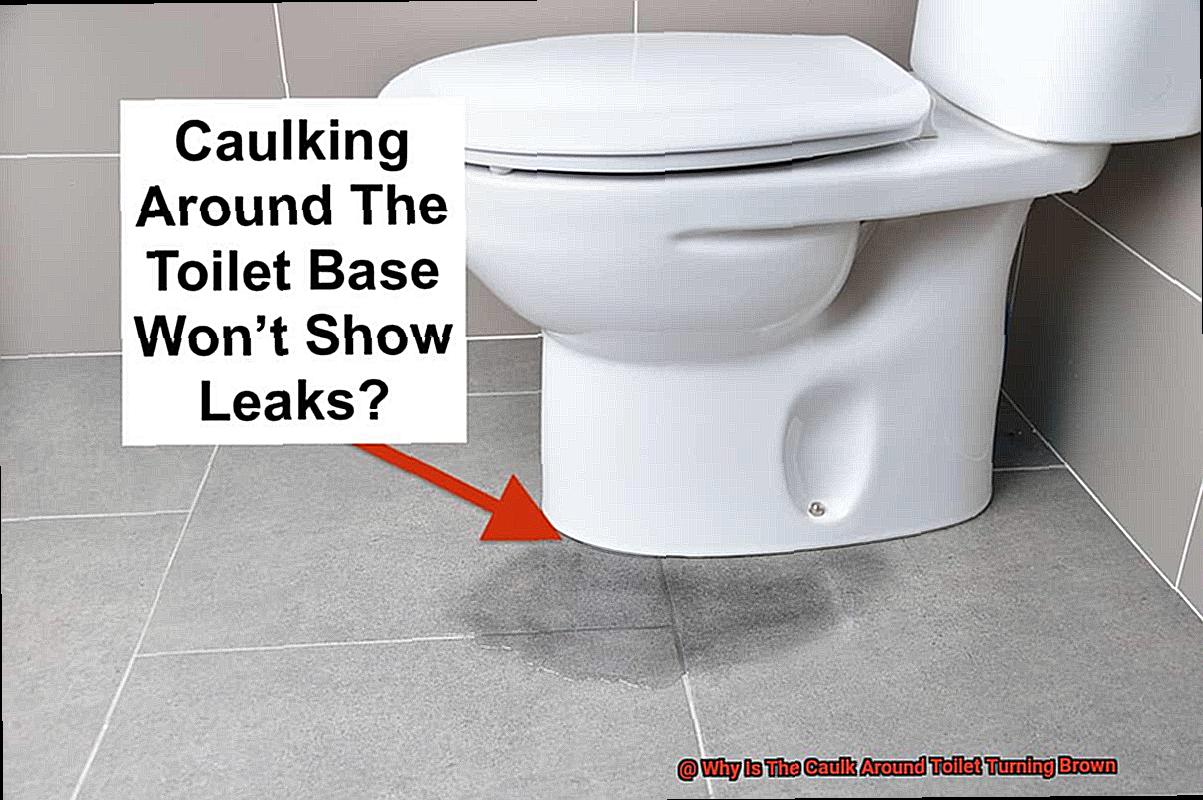
By routinely inspecting and maintaining the caulk around your toilet, you can prevent brown discoloration caused by cracks or gaps.
Not only will this keep your bathroom looking clean and fresh, but it will also help prevent mold and mildew growth that can be detrimental to your health.
Preventing Caulk From Turning Brown Around Toilet
Brown discoloration is a tell-tale sign of the growth of mold and mildew, which thrive in damp and humid environments. But worry not, with these simple tips, you can keep your bathroom clean, hygienic, and free from any unwanted guests.
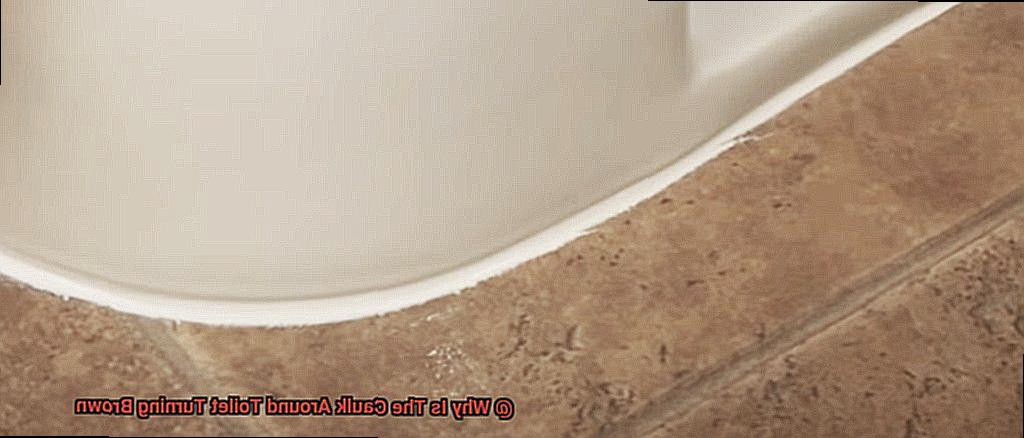
To start with, keeping the area around your toilet clean and dry is critical. Regular cleaning with a disinfectant cleaner can prevent mold and mildew growth.
Additionally, wiping down the toilet after every use can help keep the area dry and tidy. Choosing the right caulk is also essential.
High-quality caulks that are specifically designed for damp environments usually contain antimicrobial agents that inhibit mold and mildew growth. Think of it as having a superhero in your bathroom, fighting off the bad guys before they can do any damage.
Proper application is key as well. Ensure that the caulk is applied evenly, leaving no gaps or spaces for water to seep in.
Using a caulking gun can make this process quicker and more precise, just like using a paintbrush instead of your fingers. Regularly monitoring the caulking around your toilet is also vital.
If you notice any signs of discoloration or mold growth, take action immediately. A thorough cleaning and fresh coat of caulk can help prevent further damage.
Cleaning and Replacing Discolored Caulk
To start, let’s tackle the discoloration. Mild discoloration can be cleaned with a simple solution of equal parts bleach and water.
For tougher stains, try mixing vinegar and baking soda to form a powerful cleaning agent.
Once applied, let the solution sit for a few minutes before scrubbing away any grime with a stiff-bristled brush.
Rinse the area with water and voila. Your caulk should look as good as new.
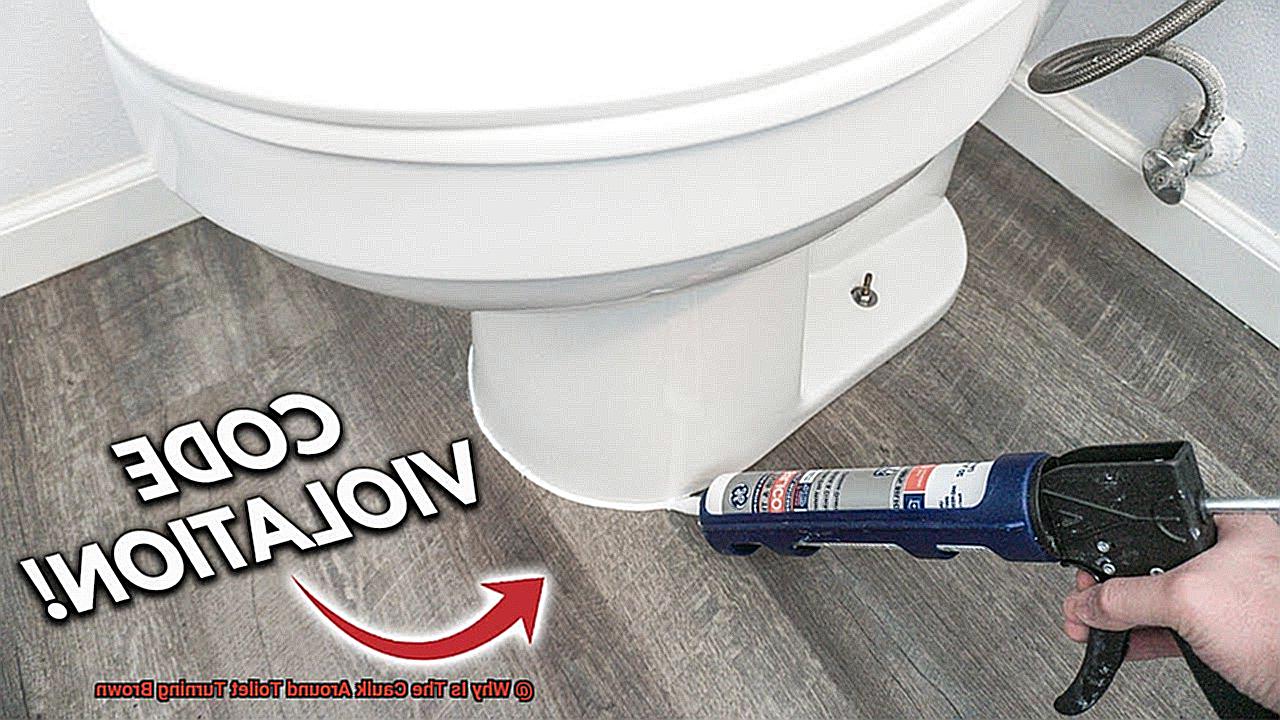
However, if the caulk is beyond repair, it’s time to replace it. Don’t worry, it’s not as intimidating as it sounds.
Gather a putty knife, caulk remover, new caulk, and a caulking gun. Carefully remove the old caulk from around the toilet using the putty knife.
Follow the manufacturer’s instructions on applying the caulk remover to ensure all remaining caulk is removed. Once the area is clean and dry, apply a new bead of caulk using a caulking gun.
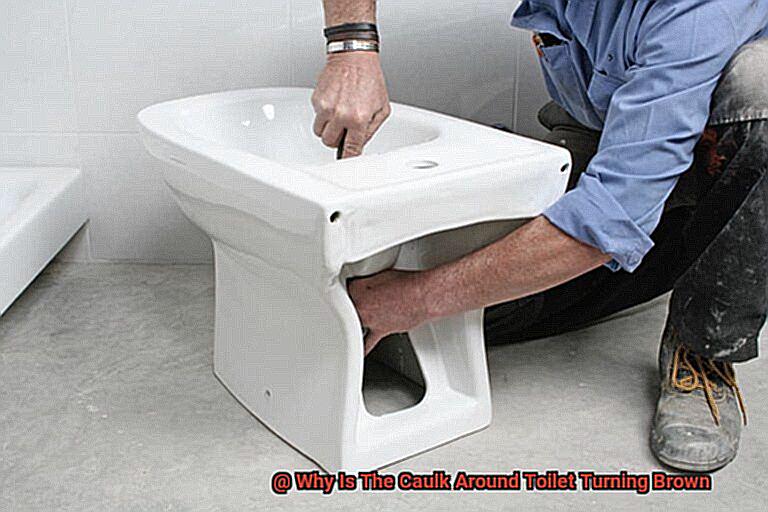
Smooth out the caulk with your finger or a dampened sponge to ensure it adheres properly and looks neat. Let the fresh caulk dry completely before using the toilet.
Regularly wiping down the area with disinfectant cleaner and keeping moisture levels low will prevent future discoloration and extend the life of your caulk.
Benefits of Maintaining Clean and Fresh-Looking Caulk
It may not seem like a big deal, but neglecting it can result in serious health hazards, leakage, and unpleasant odors in your bathroom.
First and foremost, keeping your caulk clean is essential for hygienic reasons. When mold or mildew begins to grow on the caulk, it can lead to harmful bacteria and fungi that pose a threat to your health.
By keeping your caulk clean and fresh, you can prevent the growth of these hazardous microorganisms. In addition to the health benefits, maintaining clean and fresh-looking caulk can also prolong the lifespan of your toilet.
If mold or mildew is left unchecked, it can cause damage to the caulking and even the toilet itself. This can lead to leaks, water damage, and expensive repairs.
However, a little routine maintenance can go a long way in preventing such issues. Furthermore, keeping your caulk clean helps eliminate bad odors in your bathroom.
Mold and mildew give off a musty smell that can be difficult to get rid of. By taking care of your caulk, you can eliminate the odor source and keep your bathroom smelling fresh.
Last but not least, maintaining clean and fresh-looking caulk improves the overall appearance of your bathroom. Discolored or brown caulk can make your bathroom look dirty and uninviting.
By keeping your caulk clean and fresh, you can create a more welcoming space for yourself and your guests. In conclusion, there are many benefits to maintaining clean and fresh-looking caulk around your toilet.
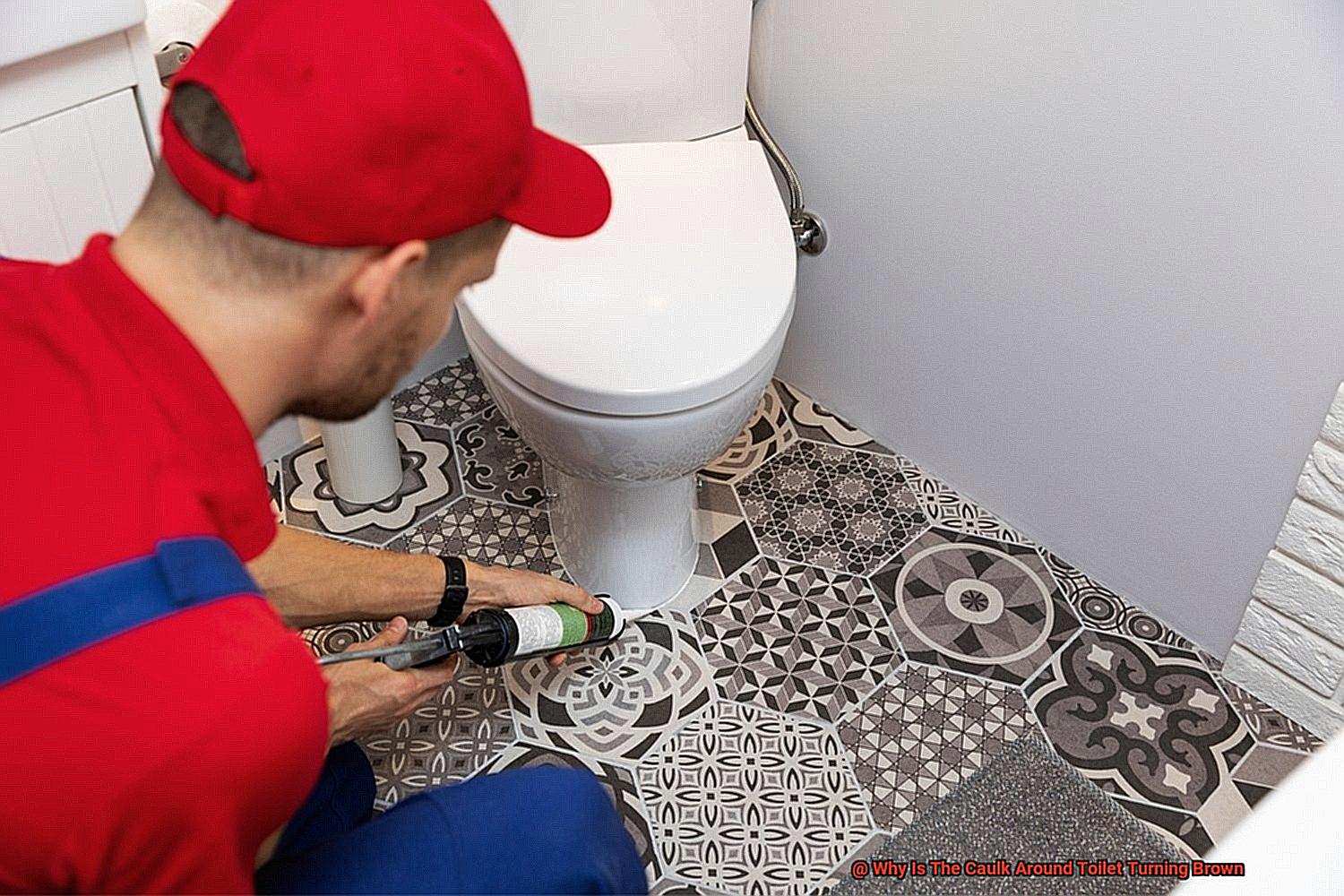
zzhdin_tnfk” >
Conclusion
Are you tired of seeing brown caulk around your toilet?
You’re not alone. This common problem can be caused by a variety of factors, such as moisture buildup, poor quality or old caulk, and cracks or gaps in the caulk.
Luckily, preventing brown caulk is easy with regular maintenance and the proper application of high-quality caulk designed for wet areas. To avoid mold and mildew growth, it’s crucial to keep the area around your toilet clean and dry.
Choosing a caulk that contains antimicrobial agents can also help reduce these pesky problems. Don’t forget to regularly monitor the caulking around your toilet to prevent further damage.
If you’re dealing with stubborn stains on discolored caulk, don’t worry. A simple mixture of bleach, water, vinegar, and baking soda can do wonders.
Maintaining clean and fresh-looking caulk doesn’t just improve the appearance of your bathroom; it also prolongs the life of your toilet, eliminates bad odors, and ensures that your bathroom remains a safe, convenient, and beautiful space for years to come.

